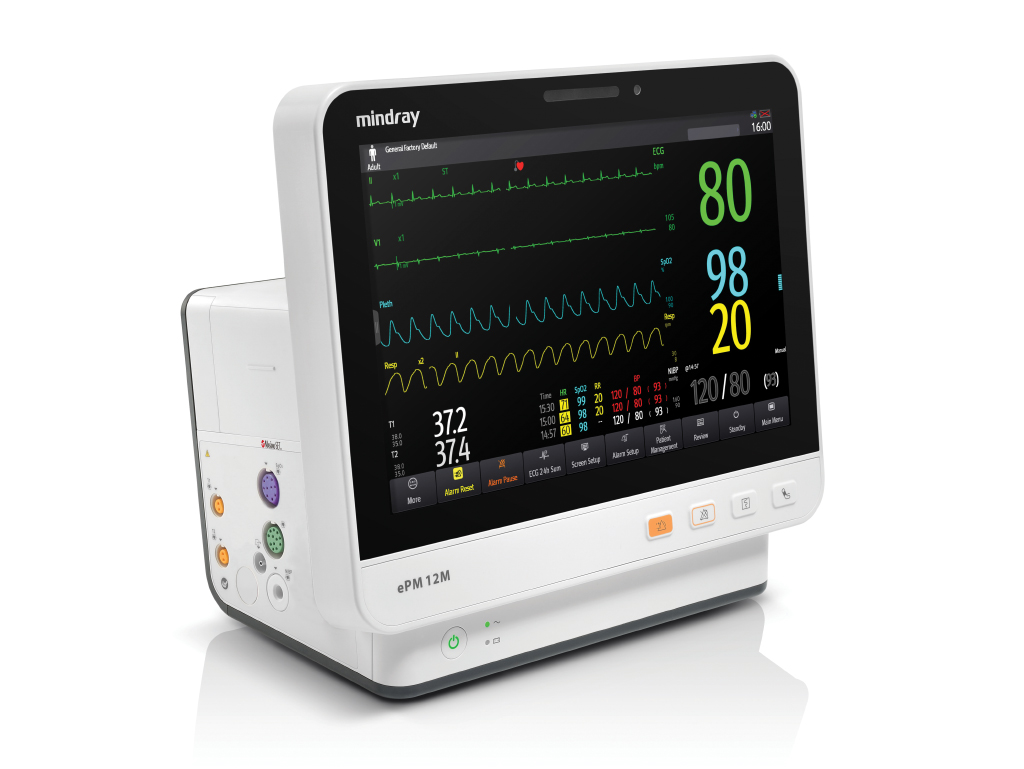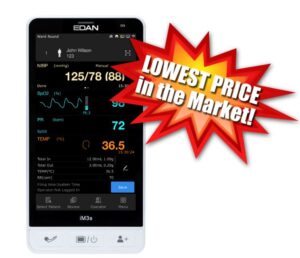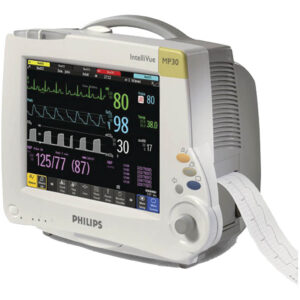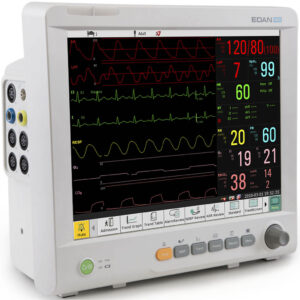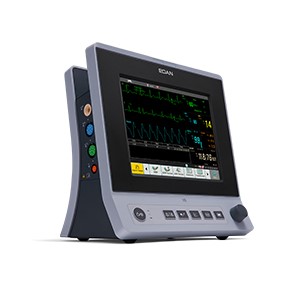Mindray ePM12 Patient Monitor
The Mindray ePM 12M is a versatile and compact patient monitor engineered for high-acuity environments like emergency rooms, ICUs, and pre-hospital transport. With a crisp 12.1-inch touchscreen and up to 10 waveform channels, it delivers rapid, accurate readings for vital parameters including ECG, SpO₂, NIBP, temperature, and respiration. Its robust battery life, lightweight design, and seamless connectivity make it a reliable solution when swift, informed clinical decisions matter most.
Emergency & Transport Monitoring—Compact, Fast, Reliable
When seconds count, the EPM Series delivers. Designed for emergency rooms, ICU, and transport care, these monitors combine sleek portability with rapid-response functionality.
Compact & Portable — Built for tight spaces and mobile use
Fast & Accurate — Real-time vitals in high-pressure situations
Extended Battery Life — Supports prolonged operation in pre-hospital care
Key Parameters: ECG, SpO₂, NIBP, EtCO₂, RR
Simplified UI — Easy to navigate under stress
Perfect for ambulances, ER bays, and anywhere urgency meets precision.
Mindray DPM Series
Dynamic Hospital Monitoring—Scalable, Flexible, Connected
For comprehensive care environments, DPM Series monitors elevate patient oversight. Ideal for wards, ORs, and long-term ICU monitoring, with advanced integration options.
Full Spectrum Monitoring — Cardiac output, IBP, ABP, multi-lead ECG
Customizable Display — Tailored views for multiple patients or modalities
Modular Configurations — Add-on capabilities for anesthesia, neonatal, and more
EHR Connectivity — Seamless data flow into hospital networks
Built for Continuity — Designed for uninterrupted monitoring across shifts
Your solution for scalable care—stable, detailed, and built to adapt.
Mindray EPM Series
Target Use: The EPM series is typically designed for emergency and acute
care settings, including use in ICUs, emergency rooms, transportation, and
pre-hospital care.
Features:
o Compact and portable: EPM monitors are generally smaller, making
them ideal for mobile or emergency situations where space and
portability are crucial.
o Quick Response: The EPM series is built for quick, reliable
measurements in fast-paced environments.
o Monitoring Parameters: Usually includes basic but essential parameters
like ECG, SpO2, NIBP, EtCO2, and respiratory rate.
o User Interface: Simple and easy-to-read interface, which can be
important for emergency staff who need to act quickly.
o Battery life: EPM monitors tend to have longer battery life, supporting
longer periods of operation in emergency transport scenarios.
2. Mindray DPM Series
Target Use: The DPM series is designed for dynamic patient monitoring in
general hospital settings, including ICUs, wards, operating rooms, and other
areas where continuous monitoring of vital signs is needed.
Features:
o Comprehensive Monitoring: DPM monitors are designed to handle a
broader range of parameters, including advanced options such as
invasive pressure, cardiac output, arterial blood pressure (ABP), and
multi-lead ECG.
o Advanced Display: Typically offers a more advanced and customizable
display, providing clinicians with detailed data and the ability to monitor
multiple patients simultaneously.
o Flexible Configurations: The DPM series often supports additional
modules and advanced features for specialized applications (e.g.,
anesthesia, neonatal monitoring).
o Long-term Use: DPM monitors are designed for long-term continuous
monitoring and can accommodate more complex monitoring needs in a
hospital setting.
o Connectivity: May offer advanced connectivity features like wireless
transmission of data to hospital networks or integration with electronic
health records (EHR).
Key Differences:
Purpose: EPM is more portable and focused on emergency and transport
situations, while DPM is more suited for ongoing, dynamic patient monitoring in a
hospital environment.
Features: DPM offers more advanced features and flexibility for complex patient
monitoring, while EPM focuses on ease of use and portability for critical, rapid-
response situations.
Customization: DPM typically offers more customization and modularity in terms
of monitored parameters, whereas EPM is simpler but still effective for
emergency care.
Conclusion:
In summary, if you need a monitor for emergency situations or transport, the Mindray
EPM series is more suited due to its portability and essential features. On the other
hand, for long-term or more complex monitoring in a hospital setting, the Mindray
DPM series would be more appropriate with its ability to monitor a wider range of
parameters and support advanced clinical needs.
Specifications:
Mindray ePM12M Patient Monitor – Technical Specifications
Physical Dimensions & Display
Size: 312 × 258 × 174 mm
Weight: 3.4 kg (standard configuration, excluding accessories)
Screen: 12.1-inch capacitive touchscreen, 1280 × 800 resolution
Waveform Channels: Up to 10 simultaneous channels
Monitoring Capabilities
ECG:
Lead sets: 3-lead, 5-lead, 6-lead, 12-lead
Modes: Diagnostic, Monitor, Surgical, ST
Bandwidth: 0.05–150 Hz (Diagnostic), 0.5–40 Hz (Monitor)
CMRR: >105 dB
Defibrillation protection: Withstands 5000V (360J)
SpO₂:
Range: 0–100%
Accuracy: ±2% (Adult/Pediatric), ±3% (Neonate)
Modules: Mindray SpO₂, Nellcor SpO₂
Perfusion Index (PI): Supported
NIBP:
Modes: Manual, Auto, STAT, Sequence
Accuracy: ±3 bpm or ±3%, whichever is greater
HR Range: 30–300 bpm
Temperature:
Channels: 2
Range: 0–50°C
Accuracy: ±0.1°C
Technique: Thermal resistance
Respiration:
Range: 0–200 rpm
Accuracy: ±1 rpm (0–120 rpm), ±2 rpm (121–200 rpm)
Power & Battery
Battery Type: Rechargeable lithium-ion, 4500mAh
Run Time: ≥4 hours
Recharge Time: ~5 hours to 90% (power off)
Line Voltage: 100–240 VAC ±10%
Frequency: 50/60 Hz ±3 Hz
Connectivity & Interfaces
Ports:
AC power connector
VGA port
USB 2.0 (×2)
Nurse call/log output
Barcode Scanner: Supports 1D & 2D
Network Printer: Supported
Module Rack: Integrated, 2-slot capacity
Wireless & Wired Networking: Compatible with CMS and EMR via HL7
Environmental Tolerances
Operating Temp: 0–40°C (without AG/CO₂), 10–40°C (with AG/CO₂)
Storage Temp: –20 to 60°C
Humidity: 15–95% (non-condensing)
Barometric Pressure: 427.5–805.5 mmHg


